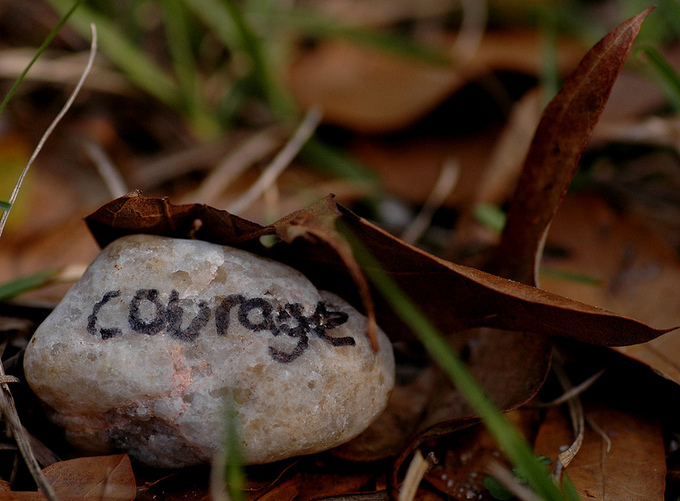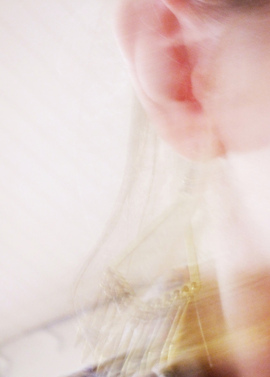 “When you find your path, you must ignore fear. You need to have the courage to risk mistakes. But once you are on that road... run, run, run, and don't stop til you've reached its end.” ― José N. Harris The word courage comes from the Latin cor and the Old French coer which denotes the heart as the seat of feelings. I love Brené Brown’s definition in this TED Talk: Courage is to tell the story of who you are with your whole heart. The key is to connect to your heart and innermost feelings and then be willing to be vulnerable and share who you are. When we finally decide that we’re not going to live a life void of meaning anymore. When we decide that we want to love our lives and make a contribution to the world. We start to move and often we come up against resistance. Most humans are not fans of change. We’re creatures of habit. Habits are not a bad thing unless the behavior is causing us pain or getting in the way of our goals. Habits help us to routinely brush our teeth, get to work on time, exercise regularly, etc. Many of us humans like the familiar. When we try to change a behavior we balk. It feels like so much work. Even if we’re trying to change our lives in a way that matches our dream life, that sluggish feeling can show up. So what can you do to develop this thing called courage? First get in touch with your heart and with who you really are. Ask: What brings me joy? What are the activities in which I lose myself? Begin to tell the story of who you are with your whole heart and be willing to share it with others. Be your authentic self. Next, create a vision of your new life and make sure that it encompasses who you are and not what you think it should look like based on what others have or say. This vision will be your pull, the thing that draws you forward. Now, because many of us are creatures of habit you may need to go deep inside your pain points. These are your reasons for wanting to change, the things that push you into your dream life. I learned this from Tony Robbins. Take some time to really feel the pain. For instance, if you’re trying to move towards the dream of being a coach or painter you could go deep into how bad you feel ignoring that side of you. Maybe you think about how small your life is, how bored you are at your current job and how much you hate wasting your life. Let the pain push you away from the life you don’t want towards the one you do want. Here are some more tools you can use to continue to develop your courage and stay persistent on your path. Make small changes Sometimes we’re ready to take the leap. We feel excited and make a big change like quit our job or put out big bucks on a coach. These can be great catalysts, but often we lose our momentum when it comes to doing the actual work. To keep going or to simply begin you can make small changes, easy commitments that will keep you moving forward. Make it simple so you’ll do it. These small changes prime you for larger ones. A big leap will then have a foundation under it in both a physical way and feeling way. For example, you decide to not just quit your job, which can feel euphoric at first but fearful later. You create a plan and make small changes like saving a little money for when you leave and building your confidence by doing some research and trying out the new work you plan on doing. Momentum builds and when you leave your job you know you have a good chance of making it work, which keeps you motivated. Being broke can motivate you, as well, but often it just puts you in fear mode and unable to think straight. It’s still possible to make it, but it may mean more hustle than you’d like. Put the As If Principle to work for you In my last blog I wrote about the book “The As If Principle” by Richard Wiseman. In it he talks about how our bodies and behaviors can create feelings in us and how that can be more effective than just changing our thinking. I think using both ways is best, but here are some ways you can use your body to help you persist through change. Tense your muscles. This makes you feel like you’re working hard. Studies showed that people who did this persisted longer at solving a puzzle or other difficult tasks. Cross your arms. This pose also helped people to persist longer at a task. It is acting as if you’re persistent. Sit up straight. This also helps you to keep you going. Studies showed that people who sat up straight for three minutes and then were told to solve a puzzle spent twice as much time trying to solve it as people who were told to slouch. Do something different. This technique convinces us that we’re not creatures of habit. The thing you do differently doesn’t even have to be related to your new life. It just has to be a change to something that you do habitually. For instance, take a different route to work or change up your morning routine. What studies showed is people who did something different changed how they viewed themselves. They no longer saw themselves as someone who blindly follows a routine but as someone who was able to take control of their lives. Use your mind Many of you have heard the saying: Change your thinking, change your life. It does work. Use affirmations. An affirmation is a statement that affirms something you want to see in your life. For instance you can say: I am a successful coach. Make the statement positive and in the present tense. Now maybe you don’t believe that yet and so you find your mind going into a negative affirmation: I’m no good at coaching or I don’t know enough. First ask yourself if this is true. It’s good to be realistic. The truth may be that you don’t know if you’re good because you haven’t tried. Maybe you need to get some training or practice. Do it and continue to affirm that you are successful at it. Envision your new life. By using your mind to envision your new life you create an opening for it to manifest. Make sure to use all of your senses and really feel how good it will be. One of the reasons this works is because it has been shown that our brains don’t make a distinction between practicing something in real life or in our minds. We can spend a few minutes every day “practicing” our new life and it will seem to our brains that we’re living it. This will help you embody the change faster. I hope you found this helpful and will continue to gain momentum in moving towards your dreams. If you loved this post, please share everywhere online. And if you have any friends who you think might benefit from these tips, please feel free to pass it along. Be sure to share your own tips in the comments below. I’d love to hear from you.
0 Comments
 "Low self-confidence isn't a life sentence. Self-confidence can be learned, practiced, and mastered--just like any other skill. Once you master it, everything in your life will change for the better." ~ Barrie Davenport You know those moments when you’re faced with something you don’t want to do like talk to your boss about a raise or a client about what you have to offer? Those moments when your heart is pounding and your hands are sweating and you’d rather be doing anything else? There is a way to instantly feel more confident in those uncomfortable moments. The techniques I share below are not just ways to calm you down like deep breathing. Though deep breathing can help the process, these techniques can actually make you feel more confident. I’ve been reading a book called “The As If Principle” by Richard Wiseman. In it are many studies that show how even though our body is responding to a situation like the ones mentioned above, our bodily responses, like the fast heart rate and sweaty hands, are common to many situations. The context in which we find ourselves having these responses triggers us to feel an emotion that matches the context. We can also choose how to feel just by positioning our body a certain way. For example, when we put our face in a smiling position, we begin to feel cheerful even if we didn’t feel that way to begin with. So here are a couple of techniques you can use in the moment to express and feel the confidence you need to get that raise or make that sale. Re-frame what’s happening in your body As mentioned above, our bodies have very few responses, so the excitement of love and the fear of asking for a raise trigger the same response. What happens is we are conditioned to choose an emotion that fits the context based on past knowledge. With awareness we can choose any emotion we want once the body begins responding. So let’s take the asking for a raise example. You’re waiting for your boss and you feel nervous. Your hands are sweaty and your heart is racing. Take a few deep breaths and tell yourself that you’re excited about getting this raise. You know your boss is pleased with your work. If you can keep your focus on that for a minute you will begin to feel the excitement. I’ve tried it in other fear situations and could get myself to actually feel excited. Take on a confident pose This technique also comes from the book mentioned above. Our bodies do affect our emotions. One study showed that people felt less pain from an electrical shock if they “acted tough” like nothing was going to hurt them and they put their bodies in a relaxed position. Let’s say you’re getting ready to make a sale. Stand tall, chest out, but don’t make your body rigid. Keep it relaxed. In a less formal situation, like a party, you can lean back in a chair with your arms draped over the back or behind your head. When you have more time here are some other ways to boost your confidence: Plan and rehearse Before your next meeting or the next webinar you give, take some time beforehand to plan what you’re going to say and then rehearse it. Do it out loud. Get members of your family to listen to you or enlist a few friends. Every time you do it you’ll feel more self-assured. If you’re going to a party where you don’t have a planned speech, you can visualize successful interactions. Smile and hold your confident pose while you visualize for an extra boost. Do something that you are a good at and love to do There are times when we fall into comparison thinking and pull our confidence way down. Or sometimes someone says something that sets us off into a spiral of self-doubt. One of the best things to do when this happens is to take action and do something that you’re great at and love to do. There’s nothing like being in your zone of genius to boost your confidence. Read positive statements about yourself out loud One of the studies in the book mentioned above had two groups of volunteers read statements out loud. The first group read statements like, “Saturn has rings”. The second group read positive statements about themselves. The second group came out of the experiment feeling great! The statements below are a little different from the example in the book. I’ve geared these towards inspiring confidence. I encourage you to create your own once you’ve got the hang of it and to use them to read out loud when you need a confidence boost. 1. I am a great ______________. 2. I can do _______________ well. 3. People love what I do. 4. I have confidence in my ability to ___________. 5. I help people ____________. 6. I am loved and appreciated. 7. I feel enthusiastic about life right now. 8. I get along with most people I meet. 9. I am optimistic about my future. 10. My work is going well. 11. I am successful at _______________. 12. I feel happy and secure in this moment. 13. People love to be around me. 14. I am full of energy and doing what I love. 15. Today is going to be a fun and successful day.  “Feeling uncomfortable is the first step towards growth.” ― L.K. Elliott You keep replaying your friend’s words over and over in your mind: You’ve changed. It’s what she said as she walked out your door. It’s true, you have changed, but does that mean you can’t still be friends? The thing is, when you really think about it, you don’t feel that comfortable around your friend anymore either. You’ve switched to a different wave length and you just don’t jive with some of your old friends now. It breaks your heart. On my path of spiritual growth I was broken to tears more than once by past hurts and self-realizations. Sleepless nights and deep melancholy plagued me at times. But I came out on the other side and I know I will during future growth spurts. Doing The Great Work hurts sometimes. Breaking up or breaking down are parts of growth, which is a process. We move through the pain and are stronger for it. We understand ourselves better and are able to help others because we have been through it. It is important work we’re doing. Here is the key to making the process a little less painful: Acceptance “Acceptance makes an incredible fertile soil for the seeds of change.” ― Steve Maraboli We can lessen the pain if we don’t resist it. Much of the pain we feel is because we’re resisting the process of change and growth. Acceptance is allowing the process to proceed so we can move through it more quickly and have less time in the uncomfortable zone. When you understand that being uncomfortable is just a part of the growth process, it becomes less painful. Why is that? It’s because we take fear of the unknown out of the equation. That fear is more painful than the actual pain. When we take some of the tension away, we relax and can let the process happen. So why is there pain in this process? Here is the quote I used in Monday’s Motivational email. It really helps bring this idea into focus: “For a seed to achieve its greatest expression, it must come completely undone. The shell cracks, its insides come out and everything changes. To someone who doesn't understand growth, it would look like complete destruction.” ― Cynthia Occelli The pain is there to tell us it’s time to change. We’re growing out of our old way of life just like the potential tree in the seed is outgrowing its casing. In order to express as a tree the seed needs to break open. In order for us to become who we are we need to break open and out of old patterns, old boxes we’ve existed in up until they started to become too small. Some of the pain we feel is also grief. There is loss involved, loss of friends, loss of a way of life, loss of our old self. These are a part of the growth process so it’s natural to feel some grief. Just remind yourself that the process of growth and change is going to involve some pain. Pain or Suffering Suffering is a choice. To suffer is to wallow in the pain and make pain and not growth the point. Suffering can get us attention or make us feel like we’re special. But what it really does is put us in victim mode as we give away our power in the process of growth. Acceptance is a way to let go of the pain so you don’t turn it into suffering. And that’s the whole point. If you don’t understand growth, then the process becomes so much more painful than it needs to be. Do the work you need to do and then let the process take hold. You are safe and always guided by Spirit. The Butterfly and Transformation I’ve learned a lot about butterflies over the past year from a friend aka The Butterfly Lady. The caterpillar trusts the process. It eats and grows and sheds its skin again and again, until the final shedding and cocooning takes place. A complete breakdown of the caterpillar has to happen before something as different as a butterfly can emerge from it. But remember, the butterfly already exists within the caterpillar just like the tree already exists within the seed. It’s just that the caterpillar had to become more fully itself before it could even discover its butterfly self. Once it was full after all that eating it could go within, dissolve and then fully emerge as its true being. The same goes for us. We grow and grow until we hit the most painful growth of all. It’s the death of our old self. It can hurt so we try to ignore it, run from it, pretend it’s not happening. But it is happening and ultimately we can’t stop it just like the caterpillar can’t stop itself from becoming a butterfly because it is already the butterfly. And we are already a divine being. We can warp the process with our resistance so it’s better to let Spirit, the same Life Force that moves through the caterpillar, move through us. Life wants to express and grow and change. Let it. The Ancient Egyptians referred to it as “the Becoming”. We are always becoming that which we already are just like the butterfly when it’s an egg and when it’s a caterpillar. The growth process, the struggle really is important. When someone helps a butterfly emerge from its cocoon, the struggle is averted. The butterfly cannot exist after that and dies. This beautiful being only exists because of the struggle. Our process can be eased along the way by teachers and friends, but they can’t go through it for us. If they try, we won’t make it. Our growth will be stunted, though we probably won’t die. This just means we’ll have more work to do. And, of course, there will be many more opportunities to grow. Just remember, in our moments of pain, when we want others to take away the struggle, they are not being mean when they refuse to help in the way we think they should. Our friends and teachers are wise to let us figure it out for ourselves. When you go through the process of spiritual growth you will gain the ability to guide others and will be wise enough to let them become in their own time and in their own way. Accept “the Becoming”. Allow the process, which is Spirit, to guide and move you into your true being. There are people who will be so grateful you did.  My journal is my constant companion. It is never far from my reach ... It is a front porch of solace and retreat when I am tired and weary. ~ Nicole Johnson, from Fresh-brewed Life: A Stirring Invitation to Wake Up Your Soul Your journal is a great place to get all those pent up feelings out. It’s also a great self-observation tool. Literary devices make for richer, more compelling stories. They enhance the story so that the reader can relate to the characters and feel like they are there, too. This is why I think these devices can help us to better relate to our personal stories and see ourselves as active participants in our own lives. Here are some literary devices and how you can use them: Stream of consciousness When writing in your journal you’re probably already using this literary device. In some novels we see what is going on in a character’s mind by way of this technique, this steady stream of thoughts. This is good way to see what’s going on inside your own mind. Metaphor You know this one. It’s when you assert that something is not just like another thing, but is the other thing to emphasize a trait. You can use this in your journal writing to discover something deeper about your feelings. For instance let’s say you rant about being angry at your boss in your journal. What does the anger feel like? Try writing it using a metaphor. Maybe you say: I’m a roaring, caged lion. This metaphor is very telling. It says some of your anger is frustration and you either feel trapped in the situation or trapped because you couldn’t express how you felt to your boss. Kennings This is a poetic device from Old Norse and Germanic poetry. It is when the poet creates a new compound word or phrase to describe an object or activity. This can help you better recognize how you are in the world. For example, instead of simply saying you feel angry at your mother you take a deeper look and ask yourself why you are angry. Let’s say you realize you’re angry because you see that you’re acting like her. You’re really angry at yourself. Take a moment and come up with a name for this. Maybe you call it becoming-my-mother-anger. Naming something is the first step in dealing with it. Now when it happens you can just say its name and immediately go into self-observation and stop the behavior. Theme The best way to use this device is to look for it in your journal rather than create it. Take a look through your journal entries for the year. Do you detect a common thread that runs through your writings? This can provide a deeper insight into what you’ve been working on; maybe it’s not what you think. Tone This device, like the one above, is best used after you’ve written something. Take one of your journal entries and assess the tone you used. Was it happy, angry, sarcastic? Perhaps you used different tones when writing about different people. This can help you see how you feel about a situation or person. Setting This is the place in which something happens. In journaling it can be helpful to you to see your situation in the context of the environment it took place in. For example, if you write about how you were unusually anxious today, also write about the setting…get detailed. Perhaps you describe your office with all its sights, sounds, textures, and smells. When it comes to sounds you describe some words you heard coming from your bosses office. One of the words was layoff. You didn’t consciously remember this during your busy day, but on reflection and using the technique of describing the setting you brought it forth. Now you know why you feel anxious and can now deal with it. Dialogue Sometimes you just can’t have the conversation you want to have with someone. Maybe it’s your boss or someone that has died. Using dialogue is a great way to have that conversation. Write what you want to say and then write what you think the other person would say. Simply carry on a conversation in this manner. Sometimes just getting what we want to say out is healing. Juxtaposition This is when you put together two or more ideas, words, images, etc. in order to contrast them and therefore see both more clearly. This is a powerful tool because it helps the reader gain insight on their own rather than being told what to think. Here is how you can use it: Maybe you need to make a choice between two jobs. Write a paragraph about each job describing how you would spend your day. Write it as a story or use images so you can compare the feel of both rather than just doing an analysis of the pros and cons. Flashback Often our journal entries are about something that happened earlier that day or week. It might be helpful to write it as a novelist would, a true account as if it were happening now. Putting yourself back into the moment can help you get in touch with your feelings. It can also help give you some perspective. Imagery The next time you write about a situation in your journal describe what you saw, heard, smelled, felt. Create a full image in order to help you revisit the situation to see if there was something you missed. Personification Giving voice to an object or animal can help us understand our attachment to it better. It can also help us become more compassionate. Choose one now and give it a try. Over the next couple of weeks test out more and see which ones work best for you. Once you’ve practiced them you’ll have them at your disposal when needed.  "The greatest weapon against stress is our ability to choose one thought over another." -William James You have a client call in 10 minutes, but you haven’t had a chance to go over their case because the thing you didn’t deal with last week has come up again. Then your husband calls and needs that information for the bank that he left on the kitchen table. You can’t find it, he’s getting upset and now your mind is in overwhelm. At this point you wouldn’t be able to find and elephant in a haystack. I’ve had days like the one described above. We all have. Luckily it doesn’t have to be a regular occurrence. There are tools to help us cope and get back to thinking straight. Below you’ll find some ways to help you get past being overwhelmed at any given moment as well as ways to prevent ending up there in the first place. What to do in the moment of overwhelm: Figure out what can wait and what can’t. In the example above, your client is more important. Tell your husband to wait until you’re done because the bank can wait an hour. Change your thinking. Stop thinking that if you don’t get everything done on your list you’ll spontaneously combust. Most things will wait. Take one action. Overwhelm can cause us to freeze up. By taking one action, no matter how small, we can melt away that stuck feeling and get ourselves moving again. For those times it truly isn’t urgent: Ignore your to-do list. Just until you calm down. Often we pile on too many things and in our minds we feel we have to do them all at once. So ignore the stuff that needs to get done and do something that’s not on the list. Maybe start that novel you’ve been wanting to write or finish that painting you started. Do something that soothes you. Listen to gentle music or a guided meditation. Take a walk or do some spiritual reading. This will bring you back to yourself where you can focus again. Focus on what drives you. In other words, do first the things that you’re motivated to do. When in the flow you’ll forget all about that to-do list and accomplish plenty. Get some rest. Don’t push yourself. You can’t keep plodding along and expect to feel better. What you can do to prevent overwhelm: Go at your own pace. Don’t worry about what other people think you should be able to accomplish or even what you think you should be able to do. Just do what you can and consider that enough. Overestimate how much time a task will take. Much of our overwhelm stems from thinking that a task will only take a few minutes when in reality it takes a half an hour. By giving yourself more time you’ll never run out of time. Create a routine and stick to it. The routine helps you keep on task within a timeframe. Over time you’ll create a habit, which will free up mind space and allow you to get some of those daily things done more easily. Get up earlier. If you know you have a lot to accomplish, start early in the day. I know that when I sleep in a little on the days I have a lot to do my morning routine goes out the window and I feel rushed. Give yourself time. Shorten your list. If you think you can’t do this, I recommend you sit down with your list and prioritize. Put those things that move you towards your goals first. Then if there is room, put in just a few chores. Make a weekly list. Sometimes I get so busy making the list that I forget to break it down. Make your list, prioritize your items and then plug them into different days of the week. Be sure to not overload any one day. Play around with these suggestions and find out what works for you. Life is too short to spend it under stress. And being under stress makes you stupid because it scrambles your brain. Boy have I experienced that one. So put a stop to it. Take back your life so you can live your dreams.  Some of you may know I’m a baseball fan, a L.A. Dodgers fan to be specific. I know, I know, the Dodgers are not an easy team to be a fan of, but this isn’t about the Dodgers and it isn’t really about baseball. It’s about our ability to stay focused in the moment. When I watch a player make a bad play and then continue to screw up I can relate. I’ve been there, I’ve done something poorly that I can usually do, or just made one of those all too human mistakes and then can’t forget about it. Because I would continue to go over the mistake, essentially live in the past, I couldn’t perform well in the present. This is what’s going on with those players. Let’s say a pitcher throws a ball that a batter hits out of the park. You can tell when they’ve been unable to let go of their mistake because they continue to pitch poorly. It’s only when they can forget about the mistake and come back to the present that they begin to throw strikes again. The faster a player can move on, the more successful they will be. Think of the superstar players in any sport. One of the things they do better than those less successful is to learn from and then forget their mistakes in the moment. This has been labeled athletic amnesia, a term first used to describe what the successful quarter back Eli Manning does. What you need to remember was best stated by the great spiritual teacher Ernest Holmes: “Never limit your view of life by any past experience.” What happened in the past does not need to dictate what will happen in the future. Get to really know that and you’ll be more open to opportunities, more willing to try again and more than likely to succeed. So how do we stay present after a screw up? I know being able to forget a mistake and move on is easier said than done. Here are some ideas for coming back to the present and not getting caught up in negative emotions after making a mistake or performing badly: Go over the mistake once only. Learn from your mistake and then move on. If you find yourself replaying it over and over learn to recognize that and then tell yourself to stop. Practice staying present. If you don’t meditate I highly recommend starting. The spiritual leader of Shambhala Buddhism, The Sakyong provides great instruction in this video. The practice of meditation will help bring awareness into your everyday life so that you will notice when you get caught up in the negative emotion surrounding a mistake. When you notice something you can change it. Distract yourself. Sometimes we just can’t let it go. We find our minds going over and over the mistake no matter what. This usually happens when it was a big mistake and in front of others. Our embarrassment is a highly charged emotion that can make letting go more difficult. This is the time to work on a task that will absorb all of your attention. You just need to get away from it and then slowly go back when the feeling isn’t so strong so you can learn from it. What if you absolutely have to continue to perform in the moment like that pitcher in the ballgame and you just can’t let the mistake go? Relax. This is one of the reasons, I believe, that ball players chew gum. It relaxes the jaw which is where a lot of us hold our tension. You can also shake your body to loosen it up, take a few deep breaths, and even count to ten. Hey, it works to calm ourselves when we’re angry with someone. When we make a mistake we are angry at someone, ourselves. Let go of perfectionism. Most likely the mistake we make will not be the end of the world. We can simply learn from it and move on. In fact mistakes help us achieve a better performance in the long run if we can learn from them.  “While the Giver archetype is celebrated in our culture, the Receiver is almost wholly unknown. The result? Busyness is a virtue.” ― Amanda Owen Of course I can, you say. You’ll tell me you give all the time without ever expecting anything in return. Yes, you can give without expecting anything in return. That’s the best way to give, but what will you have to give if you never receive anything? Think of it like this. A car can take you wherever you want to go, but it can’t give you the gift of transportation forever if it never takes in fuel. At some point it will run out of gas. And so will you if you never receive what you need. Like the quote above says, the result of not being a receiver and only a giver is busyness. And you know what busyness leads to? Burnout. You run out of fuel. The Law of Circulation states that all is flow. Think of breathing. When you breathe you are using an example of the Law of Circulation. There is an intake and release. You are receiving oxygen and giving out carbon dioxide. It’s a system. In order for it to work both things need to happen. And if they don’t, you stop working. So when you give all the time without receiving you cut yourself off from the flow, you begin to burnout and if you continue, your body will balk and just plain stop through sickness or even death. That may seem harsh, but it’s true. We are not made to only give. We are made to receive as well. And it’s imperative to our overall well-being as well as to living our dreams. So how do you get into the receiving habit? Let Go of the Guilt First and foremost you need to stop thinking of receiving as a bad thing. Our culture has put giving on such a high pedestal that we’ve forgotten its part of a system. You’ve heard the saying, “It’s better to give than to receive.” This has become so deeply ingrained in us that when someone tries to give us something we feel the need to either refuse it or turn right around and give something back. The thing is we are giving back when we receive graciously. Think about how good it feels when someone’s eyes light up with gratitude for your gift. Be the person that gives light with your gratitude. How do you let go of the guilt? Reframe how you see receiving. Tell yourself that by receiving you’re giving your gratitude. Know that by receiving you’ll be refueled and able to give more of yourself to the world. Practice Receiving Stop reading and pick up something or use your phone. Pass it back and forth between your hands. Receive it as you give it. It seems simple, but it will help you understand the Law of Circulation. It will help you understand that both giving and receiving are a part of one process. This idea came from a story about the Buddha. He he told a rich man to do this so he could learn how to give. Another practice is to let someone wash your hands. I did this in a workshop once. It was easy to be the one washing, but harder to let someone do the washing. Take turns. At some point it will be hard to tell who is giving and who is receiving no matter who is doing the washing. It’s a powerful exercise. And try this. The next time someone gives you a compliment, stop yourself from shaking your head no or rejecting it. Take a deep breath and say thank you. That’s it. Just say thank you. Do the same thing when someone offers to help you. Stop. Breathe. Accept. Practice: Stop. Breathe. Accept. Say it as a mantra so you don’t forget. No more resisting the gifts being given to you. You deserve to receive. It’s your birthright. It’s a necessary function of your body, your being, the Universe. When you receive you are open to receive more. You are open to give more. You are open to the abundance of the Universe and in the flow. The Law of Circulation begins working for you. Life becomes joyful and from there you will have the energy to manifest your dreams.  "You must live in the present, launch yourself on every wave, find your eternity in each moment. Fools stand on their island of opportunities and look toward another land. There is not other land; there is no other life but this." ~ Henry David Thoreau You must live in the present. If you want the success in life and in business that you say you want, then you must do this and not look toward another land. That other land could be the someday moment when everything is perfect or thinking you'll only be happy when you make $5,000 a month. There is no perfect someday and it is only now that happiness exists. Stop reading this for a moment. Look up. What do you see, hear, feel, smell? If you're eating while reading this, what do you taste? When was the last time you ate without doing something else and really tasted your food? And don't start to label what it is you are experiencing. Just experience it. Don't say that was a truck that rumbled by or that you love the taste of the may on your sandwich. Just experience it. Not easy. Our brains want to label and categorize. We have filters in place. We think we're experiencing when what we're really doing is conceptualizing. Stop it for a minute. Even for just one second. Now that wasn't easy. I just tried it. But I have learned to experience things as they are rather than to just name and move on, at least part of the time. It's a great practice. The implications are far reaching. What i mean is that our prejudices get disrupted and for a brief moment we can be aware of them. This means we might not act on them. At the point maybe you see where I'm going with awareness being the doorway to success. When you're in the present moment and fully aware, you're not in some idea of what you think is going on. You're not telling a story about it. And usually it's that story or idea that gets us into trouble. Let me give you an example: When my husband is late getting back from somewhere I worry. He was in a car accident a few years ago and so that comes to my mind. The thing is I know nothing about what may be keeping him. the worry stems from the story I tell myself about the situation. My mind conjures up images of accidents. I get scared. I create a stress response in my body. And then he walks in the door. Nothing happened. It was all in my mind. I don't want to do that anymore so when I start to go there I give myself other, more probable scenarios to thing about or I keep myself in the present moment. I relax into reading my book or getting some work done. It helps and I don't waste time worrying. I get my studying done or a blog post written. So you can see where not being in the present moment can thwart your success. How can it help you be successful? The present moment is a point of power. It is the only place from which you can act. You may be visiting the past or future when planning, but when you take action, you are acting from the present. If you keep in the present and take stock of the facts around you, your actions will be clearer. Here comes another example: A friend calls and leaves a message that they don't want to go out tonight. You thought they were looking forward to it. They didn't leave an explanation. Your mind starts to think that maybe they are tiring of you or that you did something wrong since they've been acting strange lately, so you begin to avoid them. The friendship fades. The thing is yo based your decision on a story you made up. You didn't know what your friend was thinking. If you had called the next day to check on them, perhaps they would have told you that they were exhausted by work for the past month. Instead you made an uninformed decision that ended the friendship. This may be extreme, but you get my point. We make assumptions all the time, but we need to have enough awareness to see when we're doing it and to check them out. The best thing to do is to just stop making assumptions or at least catch ourselves in the act. To live in the present moment more often is to give ourselves the space to watch our inner workings. When we can see what's going on inside, we can see when we're telling ourselves untrue stories. This awareness is freedom. It's a doorway to success because our decisions and actions will be based on the facts and not lies or preconceptions. Thoreau spent a lot of time in the woods. He took in his surroundings and wrote about them and his inner workings. Here are some things you can do to help create greater awareness. I'm sure Thoreau would make similar suggestions. Experience your surroundings Take time to just be. As yourself this often: Am I present or is my mind a mile away? If you're not present, come back to the moment and take a deep breath. Notice without naming. Journal Journaling is a great way to be present. You can write in detail about what you see or hear or smell. Maybe you'll write a poem. Poets don't live in their preconceptions. Well, the good ones don't. It's also a way to be present to how you're feeling at any given moment. Meditate This is probably going to come up in most of my blog posts. Meditation, especially mindfulness meditation, is the best way to train your mind to be in the present moment. It's the training that will help you ask that question above: Am I present? During mindfulness meditation you keep bringing yourself back to the breath or some other point of focus. You also stay mindful of what's going on in your mind. Give them a try. I promise you that with time and practice your life will begin to shift. Awareness is truly a doorway and not just a key to success. It's a threshold and on the other side are clarity and the confidence to move forward.  “Inner guidance is heard like soft music in the night by those who have learned to listen.” ― Vernon Howard Your stomach sinks when you realize that you don’t have enough money to pay this month’s rent. You went ahead and paid for a website that was geared towards doing what you saw others doing. You paid a lot thinking this was going to get you ahead in the game. But what you really needed to do was stop looking at everyone else and listen to your inner guidance. Have you had moments like these? Moments when you just knew you should have listened to that still, small voice. I know I have. Even though something inside told me I’m not a coach, I went ahead and started out to be one. I’ve since turned back and now I’m following my inner guidance to be spiritual guide/healer/teacher and card reader. The answers you seek always lie within you. You just need to listen. Now I’m not saying that the answers to how to do the bookkeeping for your business are within you. You need to find a bookkeeper or business consultant for that. But you can turn within and let your inner guide point you to the right person. Sometimes I let fear rule. My worry voice is so loud. It’s much louder than my guiding voice. That should be a clue right? But we’re so used to being blasted by messages in our noise and message polluted world that when we hear our worry voice shout, we pay attention. There are times you need to heed the fear voice. Like when it shouts to stop dating that bum or you should run from that job with the toxic boss. But if you relax and let the fear subside, you’ll find the quiet voice is saying the same thing in a calmer way and probably has a next step for you. The key is discernment. Here are some ways to tune into that inner guidance. Have a daily meditation practice. The only way to hear what’s going on inside is to get quiet. Take a few minutes each day to sit in silence. If it seems like your monkey mind is just too loud to hear that still, small voice, then try using a mantra or say the names of the Divine. Eventually your mind will settle down. Ask a question just before you go to sleep. Much of what you need to know is within. Planting a question in your mind gives your subconscious something to do when it gets to dream mode. You’ll either dream an answer or wake with one. Do morning pages. Write without thinking. Take a notebook and set a timer and write for 10 minutes non-stop. This is another way to tap into that inner knowing. Julia Cameron calls them morning pages, but it has also been known as automatic writing. Some can channel entities this way, but I say use it to channel your higher self. You can tap into your great grandma if you want, but it may be more helpful to see what your higher self has to say. Discernment Keys: It’s the soft, inner guidance when: it feels right. there is no fear. Well, sometimes there is some nervousness when your destiny is big. you get all tingly inside. It’s the fear voice when: you feel the fear. it shouts. you get a knot in your gut. It’s not too difficult to stop listening to those outside voices and your worry voice and tune into your higher wisdom. When you start doing this on a regular basis, you’ll find more and more you act and speak from your authentic self. This is when good things start happening in your life. This is the beginning of mastering your mind so you can manifest your destiny. |
Brick by Brick
A soul journey. Building a life
|

 RSS Feed
RSS Feed
